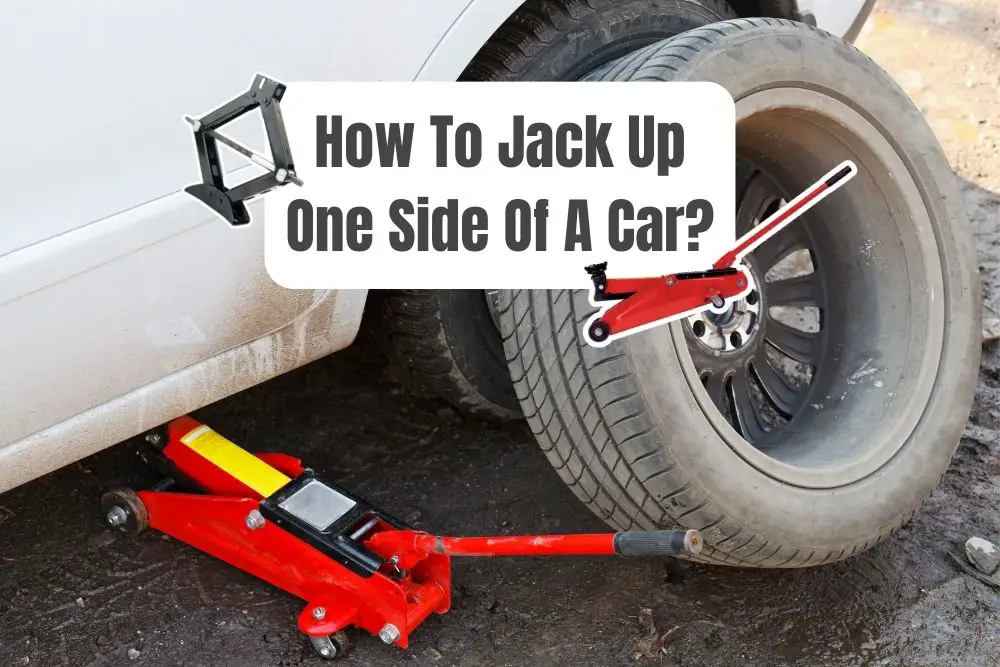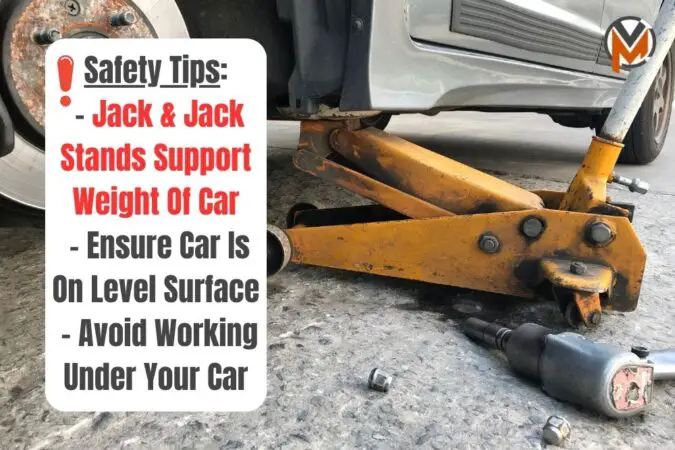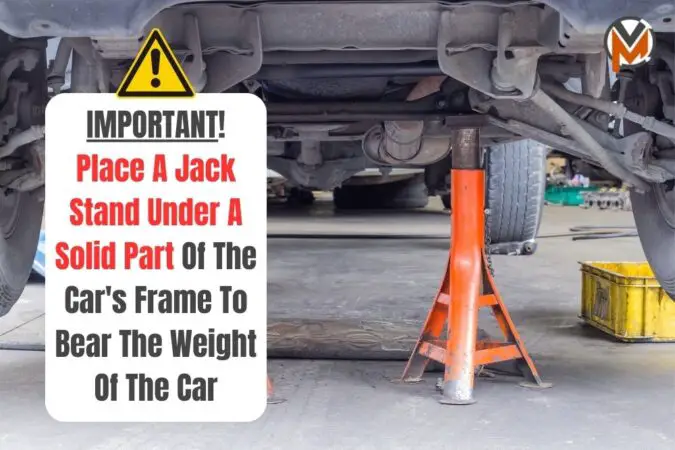Jacking up a car is one of those things that looks pretty easy on paper, but in reality, it’s far more in-depth and dangerous than it might seem. So, how can you jack up only one side of a car – can you even do it?
Well, indeed, you can! Jacking up just one side of a car is pretty normal when you’re doing something like changing out a flat tire. However, it’s rather important to practice safety precautions when doing so.
The initial jacking-up process is mostly similar, but when it comes to needing to jack up only one side of a car, you’ll need to grab wheel chocks, and place them on the opposite-side wheels to prevent slippage.
Otherwise, most of the commonplace safety tips still apply when you’re only jacking up just one side of a car. This includes procedures such as identifying the correct jacking points and using a solid jack stand.
With that in mind, here’s a step-by-step guide on how to jack up only one side of a car:
- Safety tips & precautionary notes
- Additional safety considerations
- Preparing your working area
- Locating the right jacking points
- Positioning the car jack
- Lifting up your car
- Using jack stands for additional support
- Double-checking the stability
STEP 1: General Safety Tips & Precautionary Notes
First off, let’s answer a common misconception, in that jacking up a car only on one side is a bad idea. No, actually, trying to jack up a car only on one side is a common practice, and it’s generally pretty safe.
However, it’s only safe if you do it right, and abide by certain safety precautions (including, but not limited to) that you need to bear in mind. So, please take these into consideration beforehand…
Is it safe to jack up only one side of your car(?):
- Only For Specific Tasks – Lifting up only one side of your car is suitable for tasks like tire changes, brake work, or suspension checks on that particular side.
- Not for Undercarriage Work – For much more extensive undercarriage work, it’s far safer to lift the entire front or rear of your car, or use a professional lift.
- Know Your Car’s Balance – Different vehicles have different weight distributions. Therefore, you need to be aware of how your car’s weight is balanced and how it might shift around when lifted.
- Risk of Frame Damage – Lifting one side of the car won’t typically damage the frame of your car if done at the proper jacking points. This is a common concern among folks wondering whether it’s safe to jack up a car only on one side.
- Stability Concerns – Lifting one corner can be stable if done correctly, but always ensure that your vehicle is securely supported before starting any work.
STEP 2: Additional Safety Considerations
Besides the aforementioned notes on how safe it is to jack up only one side of a car, here are a few more additional safety tips to ensure that you jack up your car safely and securely:
- Use the Right Equipment – Ensure that the jack and jack stands that you’re using are rated for your car’s weight. Using under-rated equipment can lead to failure and accidents… For instance, using a 2-ton jack when propping up a vehicle that weighs more than 2 tons.
- Stability is Crucial – The biggest risk when lifting up only one side of a car is instability. The car is less stable when lifted from one side compared to being lifted entirely from the front or rear. Always ensure that your car is on a level surface and the jacking equipment is placed correctly.
- Never Skip Wheel Chocks – Wheel chocks prevent the car from rolling and are essential when lifting one side. Place them on the opposite side of the car that you’re lifting. This should be enough to make sure that it doesn’t roll sideways and roll off the jack while you’re underneath your car.
- Avoid Working Under the Car – If you’re lifting the car just on one side, it’s advisable not to perform tasks that require you to go completely underneath the vehicle. The stability of your car in this state, when held up by the jack, isn’t as robust as when using a four-point lift.
- Regularly Inspect Your Equipment – Before each use, inspect your jack and jack stands for signs of damage or wear and tear. Compromised equipment can fail under the weight of the car.
STEP 3: Prepare Your Working Area
Now, with all those safety tips and considerations in mind, let’s get to work on jacking up your car, but only on one side. Here’s what you need to do to get started:
- Choose a Flat Surface – Begin by ensuring that your car is parked on a level, hard surface. This reduces the risk of the jack tilting or your car rolling.
- Engage Parking Brake – Always engage the parking brake before jacking up your car. That’ll add an extra
layer of safety, and security, and helps with stability by preventing any potential movement. - Use Wheel Chocks – Place some wheel chocks behind the wheels on the opposite side of the car that you’re lifting. This is a critical step to prevent the car from rolling while it’s being jacked up. For example, if you’re lifting up the left side of the car, you’ll need to place the wheel chocks on the right-hand side of the car.
STEP 4: Locating The Right Jacking Points
Next up, with your workspace prepped and ready for a lift, you’ll first need to find the right jacking points. This is where you can position the jack. This is where the weight of your rests on once it’s up in the air:
- Consult Your Car’s Manual – Your car’s owner’s (or repair) manual will specify the car’s safe jacking points. These jacking points are reinforced to bear your car’s weight and are usually located near the wheels.
- Identify the Correct Point – For jacking up and lifting only on one side, you’ll typically use the jacking points located just behind the front wheel. Or, alternatively, just in front of the rear wheel on the side you’re lifting. Again, make sure you confirm this by referring to your car’s owner’s manual.
STEP 5: Positioning Your Car Jack
Once you’ve identified where the right jacking points are, it’s time to position your car jack on the jacking points, and begin jacking your car up. Here’s what you need to do:
- Right Placement – Position your jack so that its lifting pad aligns with the jacking point. Make sure the jack is perpendicular to the ground for stability.
- Check the Ground – Ensure that the jack is on a hard, flat surface. If you’re working on a softer surface, use a large, flat piece of wood under the jack. This helps to distribute the weight more evenly.
STEP 6: Gently Lifting Up Your Car
At this stage, you can begin lifting up your car, gently and safely, once the jacks are positioned underneath your car’s jacking points. To do this, here’s what you’ll need to do:
- Raise Slowly – Begin to jack up and lift your car by pumping the jack handle slowly. Keep an eye on the car as it slowly lifts to ensure that it’s rising evenly. And, that the jack isn’t shifting around.
- Stop at the Right Height – Lift and jack up your car only as high as it’s necessary (usually just enough to get the wheel off the ground). Overextending the jack can make the entire setup unstable and dangerous.
STEP 7: Placing Some Jack Stands For Support
Additionally, another vital step of safely jacking up a car – and a step that’s often omitted, unfortunately – is placing jack stands underneath your car for added support:
- Place Jack Stands – Once your car is lifted and has been jacked up successfully, place a jack stand under a solid part of the car’s frame. Or, alternatively, another designated support area near the jacking point.
- Lower onto the Jack Stand – Carefully lower the jack so that your car now rests securely on the jack stand. The jack stand should bear the weight of the car, not the jack. This is important, as a jack can’t support a car’s total weight securely and confidently for too long.
STEP 8: Double-Checking The Stability Of Your Car
Last but not least, and before you even begin working on your car, once it’s jacked up and lifted, you need to double-check and make doubly sure that your car is stable and secure on those jack stands:
- Ensure Stability – Before starting any work, gently shake your car at the lifted corner. This is to ensure that it’s stable and securely resting on the jack stand. If it’s not stable or if there’s even a hint of it shifting around, you’ll be wise to re-do the entire process again.
- Keep the Jack in Place – As an added precaution, leave the jack in its lifting position (not supporting weight but close to the jacking point) as a backup support, just in case.




